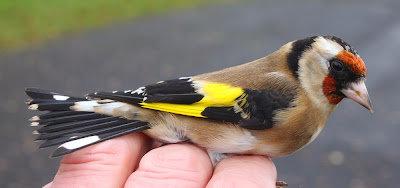It has been a rough old week of weather with no real sign of a let up to the wind and rain. But Andy and I managed to find a tiny window of dry weather this morning for a ringing session near Oakenclough.
We caught a good mix of birds by way of 21 new birds and 9 recaptures. The new birds comprised 4 Goldfinch, 2 Chaffinch, 2 Greenfinch, 4 Great Tit, 5 Blue Tit, 2 Coal Tit 1 Blackbird and 1 Robin. Rather unusually all of the 9 recaptures were Coal Tits ringed here a week ago. The single Blackbird caught was a dark-billed first winter male bird which displayed the characteristics of a “continental” type.
Goldfinch
Greenfinch
Blackbird
Chaffinch
Even though over the years I’ve ringed almost 4500 Chaffinches, it’s still satisfying to catch them on a regular basis. The Chaffinch is an interesting and accessible species, one that is eminently suitable for amateur study. See here for an earlier account of autumn Chaffinches
I may have told this story before on but here goes. The Chaffinch (Fringilla coelebs), sometimes known as bachelor finch, was described by Linnaeus in 1758 in his Systema Naturae. Fringilla is the Latin word for a finch while coelebs means unmarried or single. The English name comes from the Old English ceaffinc, where ceaf is "chaff" and finc "finch". The “chaff” part of the name arose no doubt through this farmland birds’ preference for eating chaff, the husks of corn or other seed separated by winnowing or threshing. A common call of the Chaffinch is variously described as “fink”, “vink” or “pink” and gave rise to the “finch” part of its English name.
Linnaeus thought that during the Swedish winter, only the female birds migrated south towards Belgium to Italy, leaving male birds to stay close to their territories. Although this observation was not entirely accurate there was an element of truth in the theory. The male to female ratios of Chaffinches migrating south and forming wintering flocks actually varies from year to year with the locality and dependent upon the severity of a winter/availability of food.
Chaffinch
This morning’s birding seemed rather uneventful until about 0915-1030 when we noticed a huge stream of a couple of thousand or more Fieldfares arriving from due north and heading south on a route through the hills east of the Grizedale Valley, a direction which if continued would take them over the town of Garstang. Our views from 400 yards away were limited by distance and a large plantation on the hillside and it was hard to tell if the flocks were of Fieldfares only or whether Redwings were also involved. Later we did see just a couple of Redwings.
Sightings otherwise - 1 Great-spotted Woodpecker, 1 Pied Wagtail, 2 Bullfinch, 1 Mistle Thrush.





